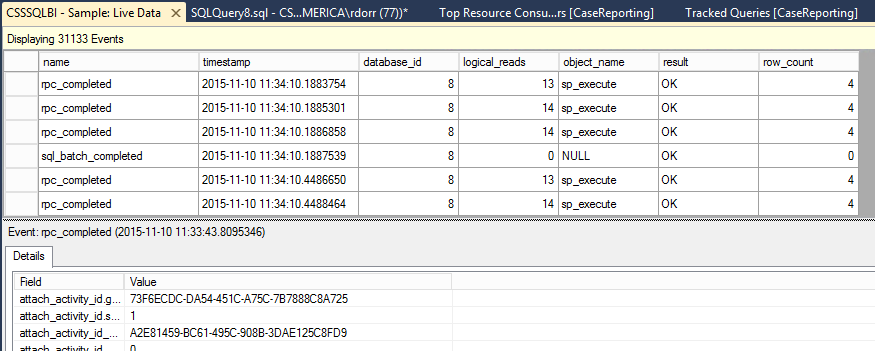SQL Server 2016 improves the XEvent Linq reader scalability and performance. The XEvent UI in SQL Server Management Studio uses the XEvent Linq reader to process the events for display. Careful study of the XEvent Linq reader revealed opportunities for scalability and performance improvements.
Note: The XEvent Linq reader is .NET based and can be used by custom applications.
Various changes were made to the XEvent Linq provider logic to reduce context switching, memory allocations and other aspects.
The following are testing results of the XEvent reader.
WITHOUT FIX |
8000 Events/sec |
WITH FIX |
80,000 Events/sec |
'It Just Runs Faster' - The SQL Server 2016 client component processes XEvent files 10x+ faster improving the responsiveness of the XEvent UI and reader capabilities.
Ports
SQL 2012 - https://support.microsoft.com/en-us/kb/3112710
SQL 2014 - https://support.microsoft.com/en-us/kb/3075950
Greg Lapinski - Senior SQL Server Software Engineer
Bob Dorr - Principal SQL Server Software Engineer
DEMO - It Just Runs Faster: XEvent Linq Reader
Overview
This demonstration shows the updated performance of the XEvent Linq Reader.
Steps
- Open SQL Server Management Studio (SSMS) and execute the following script to create and start the XEvent session on the SQL 2012 or 2014 instance.
CREATE EVENT SESSION [RPC Completed] ON SERVER
ADD EVENT sqlserver.rpc_completed
ADD TARGET package0.event_file(SET filename=N'c:\temp\RPCCompleted')
WITH (MAX_MEMORY=4096 KB,EVENT_RETENTION_MODE=NO_EVENT_LOSS,MAX_DISPATCH_LATENCY=30 SECONDS,MAX_EVENT_SIZE=0 KB,MEMORY_PARTITION_MODE=PER_CPU,TRACK_CAUSALITY=OFF,STARTUP_STATE=OFF)
go
ALTER EVENT SESSION [RPC Completed] ON SERVER STATE = START
go
Execute the following RML, OStress utility command from a Windows Command prompt on the server to produce the events.
ostress -E -S.\sql2014 -Q"{call sp_reset_connection()}" -q -r10000 -n100
Stop the event session using the following script in SSMS. (~185MB XEL file should be created.)
ALTER EVENT SESSION [RPC Completed] ON SERVER STATE = STOP
Open the XEvent file in SSMS on a SQL Server 2012 or 2014 client and note the load time
Open the XEvent file in SSMS on a SQL Server 2016 client and note the load time
Note: For comparison, make sure the file is copied locally to the client machine and the client machines have the same hardware footprint.
Hint: Try different filters and column sorting options to experience the performance gains as well.
Fact: SSMS uses the exposed Linq reader interface that can be consumed in any application.
Actual Scenarios
SQL Server 2016 has been vetted by a wide range of customers. The positive impact of these changes has been realized by:
- Security firm leveraging XEvent telemetry is able to process the data 10x faster
- Microsoft SQL Server Support saves an average of 18 minutes (per collection) on those issues requiring XEvent processing
Sample Results ( times faster)
Machine |
32GB RAM, 4 Core Hyper-threaded enabled 2.8Ghz, SSD Storage |
SQL Server |
Out of the box, default installation |
SQL Server 2014 |
9sec |
SQL Server 2016 |
4sec |
Comments
- Anonymous
May 19, 2016
Where can we download XEvent Linq Reader for SQL 2016?- Anonymous
May 20, 2016
The XE Linq Reader installs with the common tools. See https://msdn.microsoft.com/en-us/library/mt238290.aspx
- Anonymous
